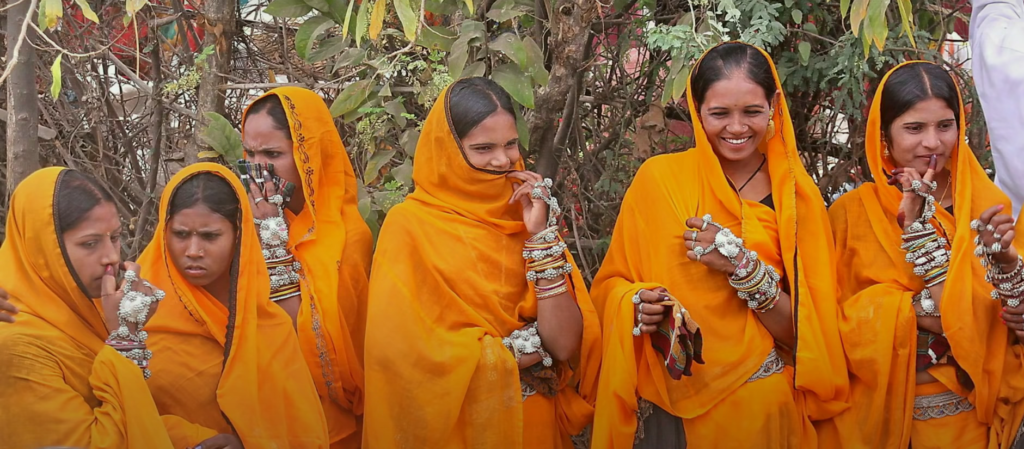Forests and hill areas around southern parts of Rajasthan were the habitants of Bhils earlier. To protect their forests and themselves, bhils used bow arrows to fight their enemies. It was also an easy weapon to make when you have a lot of wood in your hand. Scholars suggest that this popularity of bow knowledge led to the name of this tribal group. Bhil is also known as the ‘Dhanush purush of India’. In Dravidian lexis Bhil means ‘bow’. According to a 2013 report, Bhil was the largest tribe in India.

The Bhil tribe comes under the Indian government’s reservation program of positive discrimination as a Scheduled Tribe in Andhra Pradesh, Gujarat, Karnataka, Chhattisgarh, Maharashtra, Rajasthan, Madhya Pradesh, and Tripura.
There are two subcategories of bhil tribe-
- Langot bhil- They are the original forest living bhils that were lived in Madhya Pradesh. The original group can be found here living the same old life as before.
- Kshatriya Bhil/ Ugaliya bhil- They were the ones who sought refuge in the jungle when the Mughals invaded their land.
Bhil Tribe History
During British rule bhil tribe rebelled against them. Due to their and several other ethnic groups’ rebellious behaviors, these tribes were designated as criminal tribes under Criminal Tribes Act 1871 by the British Indian Empire. The rule meant that people from these tribes can be picked up, tortured, and killed by officials.
According to the historian Ram Pande, bhils protested in 1881 too when rules and custom-like police establishment, prohibition on alcohol consumption, and the ban on witches were put in by the officials. Although the campaign was redirected by a leader named Govind Guru who was able to direct the protest toward a meaningful reason. He talked them out of consuming meat and alcohol. Guru also pressurized the state to set up a village council that will be responsible for their affairs.
In 1917 Mewar State’s Girasias supported bhils to relieve them from forced labor, petty taxes, tyrannical ways of jagirdars, etc. When protest and support increased state jagirdars contacted ‘British political agent’ to let them know of the situation.
Language
Bhil people speak Bhil languages which is a subgroup of Indo-Aryan and Western Zone languages. Bhils have 36 variants of their language based on regions.
Traditions
Bhil is a culturally rich tribe. Ghoomar is bhil’s traditional folk dance. Bhilala sub-division is known for Pithora painting. Bhuri Bai was the first woman to use readymade colors and paper. Bhil painting is known for using multiple colorful dots.
Their knowledge of art and handloom manufacturing is their source of income. They also earn by doing labor and poultry.
Holi, Diwali, Dussehra, etc are some of the common festivals celebrated by this other than that they have their festivals such as Gal, Gar, Akhatij, Dhobi, Doha, Indel, etc. Bhils dance and sing during wedding ceremonies and happy occasions like childbirth.
Bhil Tribe Areas
With time bhils were distributed all over India, mainly in the areas of Gujarat, Chhattisgarh, Maharashtra, Madhya Pradesh, and Rajasthan. Bhils can also be found in Tripura and Bangladesh, in eastern India. Even though they had/have their language they now speak in the language of the region they reside in.
When bhil tribe had a widespread land their kings led them to the mountains where they thought their freedom will not be compromised. They fought with several enemies including the Mughals, Maratha, and the British to keep their freedom but everything was in vain.
According to Victoria R. William, the Bhils tribe is the most widely dispersed tribal group in India. A small group also resides in Pakistan’s Sindh.
Bhil Faith
Every bhil village has its own deity that protects the village and its members. Bhils have different deities of different aspects. They have a crop god named Karkulia Dev, they have a serpent god named Bhati de and Bhilat Dev, they have a village god named Baba dev, they have a dog god named Bhairav dev and they have a lion god named Bag dev. Apart from these gods, they have several other gods. Shiva is known to be the supreme god of Bhil. They also worship their ancestors.
Daily Life
Bhil villages have a headman who leads the entire village. The Head man is the one who resolves disputes and takes further decisions for them. Bhils have a strong sense of connection between the living and the dead. They have respect within the family and for their community.
Bhil is a conservative tribe where they only marry in their class. Even if they marry outside their class the person from the lower class needs to come to the higher class after cutting all ties with their family and friends.
Traditionally bhils are non-vegetarians. They consume alcohol made out of the Mahua flowers. In this tribe, both men and women used to wear heavy jewelry. Some jewelry was worn on a daily basis daily kept aside for festive wear.
Bhils are now asking for a separate state so that every child can be brought back to their original land with dignity.
